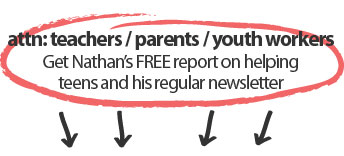 Have you ever tried to communicate with a teenager or child and just felt like you were talking to a brick wall or some other inanimate object??
Have you ever tried to communicate with a teenager or child and just felt like you were talking to a brick wall or some other inanimate object??
Have you ever had the thought or feeling when trying to get a message across to teenagers ‘when will you just get it through your thick skull?’
Have you ever just felt ‘ARGHHHHHHHH!’
I have a secret I want to share with you, but before I do I need to warn you that this email is a little lengthy, so take a few minutes and read all the way to the end – it’s well worth it!
I want to share with you a little secret when it comes to the rules of engagement and keys to engaging youth and young adults…
Here it is… drum roll please…
Not everyone speaks the same language!!
Now I’m not just talking about teen speak and this new chat and text messaging lingo like “Yolo!” and “ILY” and “ROFL” I’m talking about the way we communicate, both speaking and receiving.
So rule #6 in our Rules of Engagement is “Adjust Your Language”
According to Bernice Mcarthy there are 4 primary ways of communicating and teaching / 4 primary ways people learn and receive information:
- “Why?” (Meaning)
- “What?” (Concepts)
- “How?” (Skills)
- “What If?” (Adaptations)
When engaging and delivering any message to a group of people you are going to be addressing and communicating with all four of the primary learning and communication styles.
In your group you will have young people asking one or more of these questions:
- Why does this matter to me?
- What details are important?
- How do I do what you are talking about?
- What if I did it this way?
This concept which has been called the “4MAT” system of learning and communication goes hand in glove with Flemings learning style model “VAK”.
Fleming identified that most people have a dominant learning and communication style:
- Visual (V)
- Auditory (A)
- Kinaesthetic (K)
Visual learners and communicators learn by seeing pictures and diagrams, colour is important to them, they take notes and doodle and create imagery in their mind.
Auditory learners and communicators learn by listening to someone speaking, reciting and reading out aloud, they use verbal analogies and story telling and love a good discussion
Kinaesthetic learners and communicators learn by using their hands to make things, they move their bodies, they learn by experience, they interact with the space around them.
But even more than that – you can often pick up on whether a young person is a V, A or K in terms of their learning and communication style by the words they use when they speak:
- V – Do you see what I mean? Picture this.
- A – Do you hear what I’m saying? Does that sound good?
- K – How do you feel about that? I just cant grasp it.
Both of these models help us realise that the young people we work with (as well as the adults we work with) are all different and more importantly the SPEAK DIFFERENT LANGUAGES!
If you’re ever feeling like you’re not connecting or engaging, or maybe it appears that you’re not seeing eye to eye, maybe your conversations just sound like they’re going no where – start to tune in (rule of engagement #3) to the words that the young people are using to identify what language you need to speak to connect with them.
One of the reasons I often have teachers come up to me after my presentations and say “I dont know how you kept their attention for 60 minutes and you dont even use multimedia.” One of the reasons is I am very deliberate about the way I deliver my content and the language I use to engage the young people.
Unfortunately because the majority of the world are not aware of the intricacies of differences in personality types, learning styles and communication styles – they just end up using the styles which are most familiar and comfortable to them.
If you’re a ‘Why’ kind of person in the 4MAT model and a visual learner and communicator – you will naturally use ‘why’ and visual language – but in reality you’re leaving out a huge percentage of the rest of your classroom or group population.
Ideally when engaging and communicating with a group – we should be deliberate about using all types of language and structuring our class or our communication to ensure that we hit all 4 types of the 4MAT model and all 3 of the VAK types.
There is a whole lot more detail I could go into about 4MAT and VAK styles – but I think that’s enough for you to start thinking about and implementing without going into complete overwhelm.
Prepare your communications to cover each of the 4MAT styles:
- Why?
- What?
- How?
- What If?
Begin to identify the primary learning and communication styles of the young people you work with and make sure that when you speak to them and give them activities to do they allow them to work to their strength:
- Visual
- Auditory
- Kinaesthetic
If you would like to learn more about how to tailor your communication and strategies to effectively engage with each of the different personality types, learning styles and communication styles be sure to send an email through to Kate (bookings@nathanhulls.com) about my teacher PDs:
- How To Motivate and Engage The Unmotivated and Disengaged
- Accelerated Teaching Techniques
- The Neuro-Science of Growth Mindset and Peak Learning States
- The Happiness Effect (Social + Emotional Intelligence)
- The Coach Approach
Check out the other articles relating to “How to motivate and engage teenagers”:
- The silver bullet for student engagement
- The power of empathy in student engagement
- Emotional Intelligence in student engagement
- How to use rewards to motivate students
- How to increase student engagement
- How to effectively communicate with teens
I am regularly running professional development workshops for teachers, youth workers and professionals around based on the principals of developmental psychology, positive psychology and neuroscience to help adults understand teenagers and how best to engage, inspire and empower them to know themselves, be their best and make a positive difference in the world.
I’d love to talk to you about how I might be able to support your organisation and empower you to connect with, engage and motivate the young people you work with – for booking enquiries click here!

